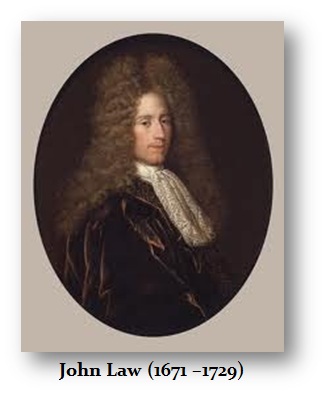John Law has been grossly overlooked, considered a fraudster, and a criminal. Ignored by most historians is the impact upon the era of John Law upon the theory of money and banking. They will often point to the fact that he had escaped a death sentence for murder in England and refuse to give him credit for much of anything. However, the truth of that matter was John Law fought a duel and won killing Edmund Wilson in Bloomsbury Square. He escaped from prison in London before being put to death. Nevertheless, that was most likely with the aid of the prison guards. Alexander Hamilton was killed in 1804 also in a duel. Although dueling was declared illegal, it was still a contest often over reputation and honor that was a long-standing tradition left over from the days of Trial by Battle.
The more interesting fact is that fleeing England, Law then embarked upon a Grand Tour that exposed him to the dynamic forces of finance that had dominated this period. He fled England and traveled to Amsterdam where he then observed the new developments in banking. Law had previously studied mathematics, commerce, and political economy in London. John remained on the Continent for about 10 years before returning to Scotland, which prior to 1707 under Queen Ann (1702-1714), had been its own country before the union of England, Scotland, and Wales.
Upon his return to Scotland, John Law wrote his best-known work entitled: Money and Trade Considered, with a Proposal for Supplying the Nation with Money (First Edition 1705, Second edition 1720). John Law was a man with extraordinary vision and comprehension. The lost art of acquiring knowledge was inquiry by observation. John Law was a man with experience in trading on the Amsterdam exchange, which led him to his observations. In Chapter I, he begins:
“How Goods are valued. Of Barter, of silver; Its Value as a Mettal, its Qualities fitting it for Money, and the Additional Value it received from being us’d as Money.
Goods have a Value from the Uses they are apply’d to; And their Value is Greater or Lesser, not so much from their more or less valuable, or necessary Uses: As from the greater or lesser Quantity of them in proportion to the Demand for them. Example. Water is of great use, yet of little Value; Because the Quantity of Water is much greater than the Demand for it. Diamonds are of little use, yet of great Value, because the Demand for Diamonds is much greater, than the Quantity of them.
Goods of the same kind differ in Value, from any difference in their Quality. (Ex.) One Horse is better than another Horse. Barley of one Country is better than Barley of another Country.
Goods change their Value, from any Change in their quantity, or in the Demand for them. (Ex.) If Oats be in greater Quantity than last year, and the Demand the same, or lesser, Oats will be less valuable.
Mr Lock sayes, The Value of Goods is according to their Quantity in Proportion to their Vent. The Vent of Goods cannot be greater than the Quantity, but the Demand may be greater: (Ex.) If the Quantity of Wine brought from France be a 100 Tunn, and the Demand be for 500 Tunn, the Demand is greater than the Vent; and the 100 Tunn will sell at a higher Price, than if the Demand were only equal to the Vent. So the Prices of Goods are not according to the Quantity in Proportion to the Vent, but in Proportion to the Demand.”
John Law’s writings influenced many, although they would never admit it. He was clearly the FIRST to use the term DEMAND and he was certainly the FIRST to join it with the word SUPPLY, for only a trader could have seen this connection in price movements of anything. John Law used these two terms to establish the first theory of price movement. Law’s views held that money creation would stimulate the economy, that paper money is preferable to metallic which was proven by the Wisselbank in Amsterdam because coins could be counterfeited or clipped. That meant each and every transaction required the tedious burden of verifying each coin. You deposited your coins in the bank. It then became much easier to pay for a transaction by writing a check or paying in banknotes. When metal was weighed prior to coins, each and every transaction became tedious. That led to the idea of first standardizing the weights, and then stamping the seal of the king to verify its authenticity. But coins could be counterfeited or clipped and we find that it was also easier to create banks to act as the mediator in transactions.





